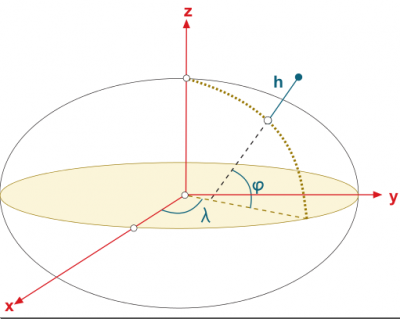If you wish to contribute or participate in the discussions about articles you are invited to contact the Editor
Cartesian and ellipsoidal coordinates
| Fundamentals | |
|---|---|
| Title | Cartesian and ellipsoidal coordinates |
| Author(s) | J. Sanz Subirana, J.M. Juan Zornoza and M. Hernández-Pajares, Technical University of Catalonia, Spain. |
| Level | Basic |
| Year of Publication | 2011 |
The [math]\displaystyle{ (x,y,z) }[/math] ECEF Cartesian coordinates of the above mentioned Terrestrial frames can be expressed in the associated ellipsoid as [math]\displaystyle{ (\varphi,\lambda, h) }[/math] ellipsoidal coordinates, where [math]\displaystyle{ \varphi }[/math] and [math]\displaystyle{ \lambda }[/math] are respectively the latitude and longitude from the ellipsoid, and [math]\displaystyle{ h }[/math] the height above it. Figure 1 illustrates the relation between Cartesian and ellipsoidal coordinates. The equations associated to this transformation are given in Ellipsoidal and Cartesian Coordinates Conversion.

